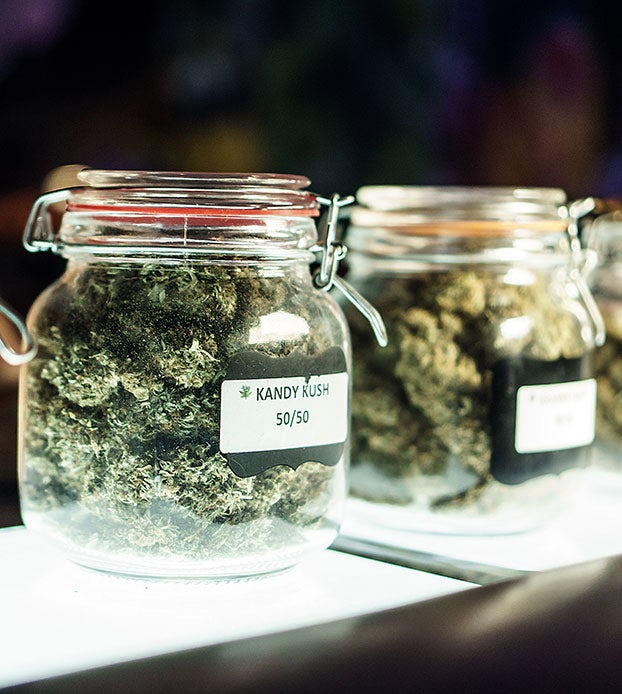If you’re new to cannabis, you may think that all weed smells the same. But once you’ve spent some time with the plant, the nuances and complexities appear. Different strains have aromas of lemon, pepper, and even gasoline. These odors are thanks to terpenes, chemical compounds that contribute to both the smell and taste of cannabis, and perhaps certain effects of different strains as well.
Exactly how much terpenes impact your experience and the entourage effect (the combined effect of all the chemical compounds in cannabis) is unknown, but there is some emerging evidence – and countless anecdotal reports – that terpenes indeed play an important role in the effects of cannabis. Most jurisdictions don’t require cannabis companies to include the terpene profiles on labels, and many labs do not evaluate the terpene content of cannabis – but that doesn’t mean it’s unimportant. 1 2
“Learning about terpenes is a great way to understand how other ingredients in cannabis [outside of THC] alter its effects,” Amanda Reiman, Chief Knowledge Officer at New Frontier Data, told The Cannigma. “Terpenes have therapeutic value on their own and THC is just one part of the overall effect of cannabis. Terpenes may be able to help you get specific desired effects and potentially moderate the effects of cannabis.”
Learning how to identify terpenes by scent is a valuable skill for any cannabis consumer and you don’t have to be a connoisseur to master it. This skill allows you to identify and understand which cannabis strains may work for you and which don’t, without necessarily needing the certificate of analysis (COA). While analytical laboratory information is great to have, it’s often not readily available or easy to read. But you don’t need a lab test to learn how to understand your weed by sight and scent – you just need knowledge, a nose, and some practice.
Why do some cannabis strains smell better than others?
The short answer is personal preference. Your endocannabinoid system is like your fingerprint, wholly unique to you. Similarly, our sense of smell (the olfactory system) is personal to us and closely connected to the brain’s limbic system – which is important for emotions and memory. To put it simply, your life experience and memories can significantly impact how different scents affect your mood. 3
While you can learn how to identify a multitude of terpenes, that doesn’t mean they’ll all smell appealing to you when combined together in cannabis products. There are a host of nuances that dictate whether or not a bud smells good to you personally. If it does, you’re likely to have a better experience. If it doesn’t, it’s probably not the strain for you.
Common terpenes in cannabis
While there are up to 200 terpenes that occur in cannabis plants, a handful of them are most commonly encountered in modern, everyday cannabis strains.
| Terpene | Main Scent |
|---|---|
| Myrcene | Earthy, spicy |
| Beta-caryophyllene | Pepper, spicy |
| Pinene | Pine trees, woody |
| Ocimene | Earthy, sweet |
| Humulene | Earthy, hops |
| Terpinolene | Floral, herbal, fuel (gas or diesel) |
| Linalool | Floral, lavender |
| Limonene | Citrus, lemon |
Understanding terpenes to improve your cannabis experience
It takes knowledge and practice to recognize the subtleties of terpenes in cannabis but with a little time, you can identify common terpenes in cannabis strains with nothing more than your nose. This information can help you improve and further customize your cannabis experience by finding terpenes profiles that are most pleasing to your endocannabinoid system.
Ways you can practice identifying terpenes:
- Seek out flower strains that include the terpene profile on the package. If your local dispensary doesn’t carry any products that include the terpene profile, request the testing results.
- Keep a consumption journal. Detail the type of cannabis you’re consuming and any information you have about it. If it doesn’t have a terpene profile, note what aroma you notice. By adding in the smells of the strains, you can create your own personal data log to help you dig down and determine not just what cannabinoid balances work for you, but the terpene profiles you prefer as well.
- Identify terpenes in nature by smelling the plants around you. Get to know the plants around you and identify which aromas smell particularly appealing. “Smelling other live plants is a great way to get familiar with the terp profiles in canna and what you like,” Reiman suggests.
- Notice the aromas in your foods. Terpenes are abundant in produce, spices, and herbs. What foods smell enticing, and which ones don’t? Identify those odors. “We eat with our eyes and noses first. Learn about scents around you and the ones that draw you in,” Reiman says.
- Try a terpene tasting kit. Similar to a wine tasting, a terpene tasting kit is a package of terpene isolates for your sampling pleasure. These kits teach you how to identify individual terpenes by smell (or taste too, if diluted) so you can better recognize them when they appear in cannabis and throughout nature. The Trichome Institute, Golden Apple, and Abstrax Tech all sell terpene tasting kits.
- Invest in a course. If you really want to take your understanding of terpenes, and cannabis as a whole, to the next level, invest in a cannabis course from Ganjier or Interpeneing. Led by plant experts, these courses will take you down to the molecular level of cannabis and back out again to give you a holistic understanding of the plant and its compounds, terpenes included.
Identifying cannabis scents from everyday life
There is plenty of overlap between the scents in your everyday life and the recognizable scents in cannabis. Some scents are heavily attributed to a single terpene, but most are made from a blend of several different compounds.
- Citrus – if you’ve eaten lemons, limes, or oranges, you’ve come into contact with limonene. This terpene is found in the rinds of citrus fruits and is a common secondary terpene in many cannabis strains.
- Floral – floral aromas come from a few different terpenes, including ocimene and linalool. Linalool’s floral aroma is easily recognizable for anyone who’s been around lavender plants, while ocimene’s aroma has more of an earthy base to the floral scent.
- Fuel (diesel/gas) – the gasoline-like smell of some strains may be confusing to a new cannabis consumer – what terpene could possibly be responsible for making a plant smell like fuel? Terpinolene is often described as smelling gassy or similar to fuel, but it can also be a combination of terpenes.
- Pine – pine scents come from, you guessed it, pinene. Pinene is the most abundant terpene in the world, found in coniferous trees, among other plants, across the globe. If you have a real Christmas tree in your house, you’re filling your space with pinene.
- Earthy – an earthy scent is common in cannabis because it can come from a variety of terpenes, including myrcene, ocimene, or humulene. Since myrcene is the most common terpene found in North American and European varieties, you’ve likely smoked (or eaten) this terpene in your weed before.
- Spicy – while spicy scents can come from many terpenes in nature, in cannabis it’s usually due to the presence of beta-caryophyllene. Also found in black pepper and cinnamon, BCP has a distinctly spicy note.
- Coffee – the same compound that can produce the skunky smell in cannabis also contributes to the sharp, acidic scent of coffee.
- Chocolate – While cannabis with a chocolate aroma is rare, there are a few strains with delicious cocoa undertones. Benzaldehyde and trimethylpyrazine, compounds formed when cannabis is smoked, can contribute to the joint smelling like a cup of joe with cocoa, burnt sugar, or nutty aromas.
Volatile Sulfur Compounds
Terpenes are not the only chemical compound responsible for the aroma of plants. Another source of odor in the natural world is volatile sulfur compounds, or VSC, for short. You’re likely familiar with VCS in your everyday life (like the tang in raw onion or garlic) but these compounds can also contribute to cannabis scents. 4
- Cheese – If you’ve come across cheesy-smell strains before, you can thank the VSC methyl thio butyrate, which has a cheesy, musty aroma.
- Skunk – love it or hate it, the skunky smell of cannabis is unmistakable. A 2021 study identified a VCS called “3-methyl-2-butene-1-thiol” or prenyl thiol, that’s responsible for the iconic smell. 5
What are terpenes?
Terpenes make up the largest and most diverse class of naturally-occurring compounds known to science. Terpenes can be found all over nature, and in particular are found in plants and insects all over the world. They serve specific purposes across the plant kingdom such as attracting pollinators, deterring predators, and protecting plants from the elements. They are often biologically active compounds too, meaning that when they are consumed or used by people or animals, they have a physiological effect. 6 7
There are thousands of different terpenes in the world and hundreds in the cannabis plant, but some are more common than others.
Understanding terpenes
Terpenes are made up of small hydrocarbon structures called “isoprene units.” All hydrocarbons are composed entirely of carbon and hydrogen (as stated in the name), and each isoprene unit is made of five carbons and eight hydrogens (C5H8). Almost like bendy legos, these building blocks are used by plants to create chemicals that help them combat pests, communicate with other plants, and attract pollinators. Just like legos, these isoprene units can be arranged in countless different ways to serve any number of purposes for plants and animals. There have been over 80,000 terpenes identified in nature so far and the isoprene units serve as building blocks for all of them. 8 9
What are terpenoids?
Different combinations and arrangements of isoprene units (ie building blocks) allow for the creation of different terpenes, each with unique characteristics. Terpenes can also interact with oxygen to form terpene-like molecules known as terpenoids. 10 11
In fact, one of the most commonly discussed cannabis terpenes, linalool, is actually a terpene alcohol (aka a terpenoid). For simplicity, the term “terpene” typically serves as an umbrella term to encompass this large class of chemicals, which technically would be best described as terpenoids.
Where are terpenes found around us?
Terpenes are everywhere, both in the natural and manufactured world. When it comes to cannabis, the structure that makes and stores these aromatic oils is called the “trichome.” Trichomes are found on the flowering part of the cannabis plant.
Despite being readily abundant in plants and nature, many terpenes can also be produced in a laboratory using chemicals or even other terpenes as precursors.
Aromatically, terpenes are used in perfumes and essential oils. In fact, terpenes and terpenoids are the primary constituents found in all essential oils. And because terpenes can help encompass many fruit-like and herb-like flavors, they’re often used as natural flavoring in processed foods too. But it’s not all synthetic. If you’re eating fresh fruit, herbs, and vegetables, you’re consuming terpenes.
Sources
- Marinotti O, Sarill M. Differentiating Full-Spectrum Hemp Extracts from CBD Isolates: Implications for Policy, Safety and Science. J Diet Suppl. 2020;17(5):517-526. doi: 10.1080/19390211.2020.1776806. Epub 2020 Jun 16. PMID: 32543253.
- Pamplona FA, da Silva LR, Coan AC. Potential Clinical Benefits of CBD-Rich Cannabis Extracts Over Purified CBD in Treatment-Resistant Epilepsy: Observational Data Meta-analysis [published correction appears in Front Neurol. 2019 Jan 10;9:1050]. Front Neurol. 2018;9:759. Published 2018 Sep 12. doi:10.3389/fneur.2018.00759
- Herz RS. The Role of Odor-Evoked Memory in Psychological and Physiological Health. Brain Sci. 2016;6(3):22. Published 2016 Jul 19. doi:10.3390/brainsci6030022
- Qian et al.; Volatile Sulfur Compounds in Food. ACS Symposium Series; American Chemical Society: Washington, DC, 2011.
- Iain W. H. Oswald*, Marcos A. Ojeda, Ryan J. Pobanz, Kevin A. Koby, Anthony J. Buchanan, Josh Del Rosso, Mario A. Guzman, and Thomas J. Martin. Identification of a New Family of Prenylated Volatile Sulfur Compounds in Cannabis Revealed by Comprehensive Two-Dimensional Gas Chromatography. ACS Omega 2021, 6, 47, 31667–31676 Publication Date:November 12, 2021 doi: 10.1021/acsomega.1c04196
- Cox-Georgian D, Ramadoss N, Dona C, Basu C. Therapeutic and Medicinal Uses of Terpenes. Medicinal Plants. 2019 Nov 12:333–59. doi: 10.1007/978-3-030-31269-5_15. PMCID: PMC7120914.
- Beran, F., Köllner, T.G., Gershenzon, J. and Tholl, D. (2019), Chemical convergence between plants and insects: biosynthetic origins and functions of common secondary metabolites. New Phytol, 223: 52-67. https://doi.org/10.1111/nph.15718
- Ibid.
- Guimarães AG, Serafini MR, Quintans-Júnior LJ. Terpenes and derivatives as a new perspective for pain treatment: a patent review. Expert Opin Ther Pat. 2014;24(3):243-265. doi:10.1517/13543776.2014.870154
- IUPAC. Compendium of Chemical Terminology, 2nd ed. (the “Gold Book”). Compiled by A. D. McNaught and A. Wilkinson. Blackwell Scientific Publications, Oxford (1997). Online version (2019-) created by S. J. Chalk. ISBN 0-9678550-9-8. https://doi.org/10.1351/goldbook.
- Sommano SR, Chittasupho C, Ruksiriwanich W, Jantrawut P. The Cannabis Terpenes. Molecules. 2020;25(24):5792. Published 2020 Dec 8. doi:10.3390/molecules25245792
Sign up for bi-weekly updates, packed full of cannabis education, recipes, and tips. Your inbox will love it.

 Shop
Shop Support
Support


















